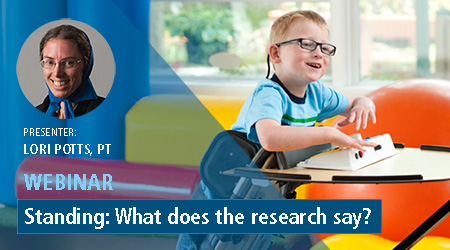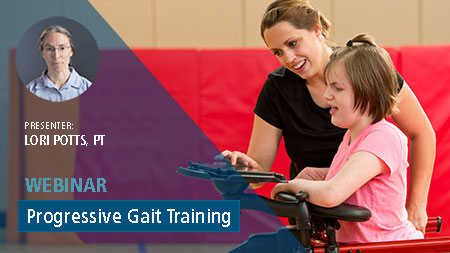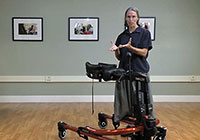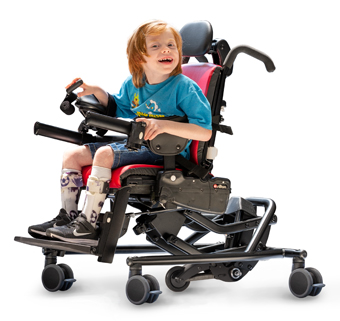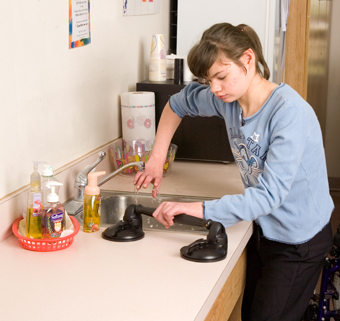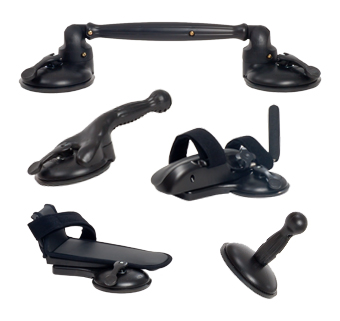Sitting for Participation: What does the research say?
A webinar by Lori Potts, PT
A summary of research evidence on adaptive seating for postural control, head control and use of upper extremities. This is followed by a discussion of outcomes relating to participation and to body function and structure.
Watch Part 2: Functional sitting with the Activity Chair
Transcript
(Slide numbers correlate with slides on the pdf.)
Slide 1
Welcome. Thank you for joining us to look at research on adaptive seating. Please contribute comments or questions on the youtube chat. I’ll respond after the webinar.
Slide 2
As we know, the systematic review is considered the highest level of evidence. Articles in a review have been critically evaluated, and only studies that meet the criteria are included. The researchers may assign a level of evidence to each article included in the review.
Slide 3
We are familiar with the GMFCS, developed in the late 90’s. Research before that time won’t identify research subjects with these levels. Level 3 children have loss of that ability for direction-specific adjustment for sitting posture, particularly when they are using their arms to reach – their intrinsic ability to modulate muscles to control arm movement is more limited. Their bodies may compensate, and certainly they have to give attention and energy to the task of sitting and controlling arm movement.
Slide 4
Then, 40% of children with CP are at levels 4 and 5. These children clearly have deficits and dysfunction in direction specific adjustment of postural muscles for that ability to maintain the center of gravity over the base of support when sitting.
Slide 5
We’ll start out with looking at available research on these aspects of sitting ability.
Slide 6
Here are four adaptive seating interventions studied for their effect on sitting postural control.
Slide 7
I won’t read every detail here, this is for your own reference. We notice not that may articles actually qualified for inclusion in these reviews. The studies discussed in the next slides were in these reviews about postural control and adaptive seating.
Slide 8
Some of the beginning research in adaptive seating was with the so called saddle seat. This placed the child’s legs with abduction/outward rotation of hips, an anterior tilt of pelvis with midline trunk posture, and equal weight bearing through the lower extremities.
For children with cerebral palsy - when placed on saddle seating; findings showed that trunk and spinal extension was increased.
Slide 9
Again, these details are for your reference. Notice that the research is from more than 20 years ago, with small numbers in the studies. Two of the studies were assigned a low level of evidence in the 2008 Systematic Review by Julie Chung. However, we do conclude that the saddle-sitting position promotes trunk extension.
Slide 10
Naturally, we immediately think that more back extension is better. But this 2001 study looked at erect versus crouched sitting for children with spastic diplegia, challenging their sitting balance on a movable platform. The children actually showed better modulation of their posture while in their typical crouched sitting position. The second study in ‘05 made the observation that reaching quality was better in the crouched sitting positon. I’m not promoting a kyphotic posture here, it’s just a reminder that each child’s postural solution is the outcome of a dynamic interplay of their intrinsic body function, their own past experience, and the environment-task context. (No adaptive seating involved here, so these not in those systematic reviews.)
Slide 11
That brings us to a discussion of the functional sitting position. These three studies in the early 1990’s looked at children positioned with symmetrical weight bearing on ischial tuberosities, hips fixed with a belt; thighs separated by abduction orthosis, and foot rests. Notice that the line of gravity of the upper body is anterior to axis of rotation at ischial tuberosities. They are sitting with seat level or an anterior tilt, and have a table or tray. What were the findings? Improved postural control.
Slide 12
And here are the details, for your own reference. Notice that the third study, published in 1995, was actually a 5 year follow-up. The children who discontinued use of the functional sitting position actually deteriorated and showed worsened trunk control.
Slide 13
What about seat surface inclination? The research shows varying outcomes. It does seem that a 10 degree anterior tilt may improve back extension.
Slide 14
More details. What is interesting to see with the second study here is that moving beyond to 15 degrees of anterior tilt results in increased extensor tone of the back along with less variability of movement of the head. The researchers recommend the 10 degree anterior tilt as being beneficial. With the third study, notice that the posterior tilt improves lower limb stability which is interesting.
Slide 15
Now we’ll look at the research on Dynamic seating.
Slide 16
This study by Cimolin in a 2015 review showed that the dynamic backrest enabled better positioning of the pelvis, so the children did not slide down in the seat, but also their upper limb coordination improved which is remarkable. Those same findings were borne out with the 2010 study with the same seating device. The trends with the Hahn study are also interesting though not statistically significant.
Slide 17
Now let’s move on to look at research on adaptive seating and upper extremity function.
Slide 18
Here are four adaptive seating interventions studied for their effect on arm and hand use. Some of these articles we’ve already mentioned earlier.
Slide 19
We have these systematic reviews as well which all include mention of adaptive seating and upper extremity function. You can certainly come back to this slide for the details.
Slide 20
We described the saddle seat position earlier. Interestingly, these studies showed no measureable effect with this position on upper extremity function.
Slide 21
We also discussed the research on the Functional Sitting Position earlier. These studies did show improved arm and hand use with this position.
Slide 22
What about anterior tilt versus posterior tilt? It simply is not so easy to make generalizations from the available research.
Slide 23
This 1987 study actually showed best performance for spastic subjects at a horizontal level seat position. The 15 degree anterior tilt impeded performance for children with athetoid CP. The next study showed no significant difference between positions. The 1999 study was with children ages 3 – 18 months. For these infants, the semi-reclined position resulted in more activation of those muscles involved with reaching.
Slide 24
Here are additional studies that were not included in the systematic reviews. These studies suggest that there is a difference in response to seat position between children with unilateral CP versus bilateral CP, and that more postural instability may occur with reaching from a posterior tilt position.
Slide 25
You can certainly come back to this slide to capture all the details, but these researchers were evaluating reaching tasks in a variety of sitting conditions, and the first two studies show differing results between unilateral and bilateral cerebral palsy. It seems that the children with unilateral spasticity certainly benefit more with an anterior tilt than do those with bilateral spasticity. The third study does not specify CP type and concludes a benefit with anterior tilt overall.
Slide 26
This 2017 study also looked at arm control, comparing a standard chair, adaptive seating system, and custom-made orthosis. Both the adaptive seating and custom-made orthosis showed significant improvement over the standard chair. However, there was no difference between these two interventions looking at data of the entire group of 20 subjects with the sitting assessment scale.
Slide 27
Now we’ll discuss Segmental Control. Segmental control is a specific method of providing support at varying levels of the trunk, from full support at the level of the axilla, to systematically reduced support down to the level of the pelvis.
Slide 28
This assessment enables a new perspective on the treatment of deficiencies of trunk control –because it offers a ‘level by level’ assessment and treatment approach for practicing and gaining trunk control.
SATCo begins with a segmental assessment of trunk control. The evaluator progressively changes the level of trunk support at seven distinct levels. Beginning from a high level of support at the shoulder girdle, which allows an assessment of cervical (head) control. Then, support at the axillae to assess upper thoracic control. Then at the level of the inferior scapula for mid thoracic control, at the lower ribs for lower thoracic control, below ribs (upper lumbar control), pelvis (lower lumbar control), and finally, no support, which of course measures as full trunk control.
What is exciting about this evaluation tool is that it assesses more than one aspect of postural control: 1. static (or steady state) control 2. active (or anticipatory) control and 3. reactive control (maintaining or regaining trunk control following a threat to balance, produced by a brisk nudge).
Slide 29
Here is a study published in 2016. For children with mild CP, the level of support had no effect on posture or reaching. For those with moderate CP, when support was only provided at the pelvis, they did not do so well as when support was provided at higher levels.
For those with severe CP, they did best with support at the axilla. Any support mid-ribs level or lower showed worsening of their ability for reaching tasks.
For children with CP, we know that their postural ability to fine-tune those direction specific adjustments to task and environment conditions is impaired. This research shows that they may achieve reaching tasks with more success when external support is provided and aligned with their intrinsic level of trunk control.
Slide 30
At this point, I’d like to take a little break from these slides and invite a therapist from the field to share about her work with the SATCo in a public school system in Maryland. They’ve been incorporating concepts of the SATCo with both assessment and intervention, using Rifton’s activity chair. So let’s take a few minutes on that.
Slide 31
Big thanks to Jocelyn for sharing with us from her experience with SATCo. So now we have discussed sitting postural control and upper extremity function. That brings us to head control, which we know is important in feeding or eating, speaking and communication and certainly reaching which requires eye-hand coordination.
Slide 32
Here are seating interventions studied for their effect on head control. Only one of these articles was included in the systematic reviews, the tilt-in-space article.
Slide 33
In 1993, Angelo looked at one 9-year-old child with cerebral palsy, and the effect of two different posterior tilt positions on the child’s head control. The finding was that a 15 degree posterior tilt showed improvement when compared to horizontal. This is a low level study involving one child; it covers a time span of 10 weeks and measurements were done in the classroom environment.
Slide 34
On these next two slides I’ve included studies with Segmental Control. The findings here showed that children with spastic CP had more head sway with their eyes closed, which indicated that they relied on the visual input along with the vestibular and somatosensory input for their sitting postural control. Children with dyskinetic CP on the other hand, had better stability with their eyes closed. To me that indicates that they had a strategy for intrinsic control that for some reason was more successful without the visual input.
Slide 35
More on Segmental Control. Please come back to this slide for all the details. Essentially, this first study concludes that the Level 4 children showed no difference to head sway between the different levels of support, which indicates they had developed an intrinsic motor strategy to stabilize their head during quiet sitting.
The second study showed that when very high levels of support were provided for Level 4 children, this actually worsened their head control, suggesting that too much support may interfere with a child’s own control of their postural sway.
Slide 36
This 2018 study is with the Head Pod, which gives support to the head while allowing for neck rotation. The study began with 14 children, although not all stayed through the full six months of the study. In that time, there was significant improvement in the ability of these Level 5 children to actively maintain an upright position of their head.
Slide 37
If we think about it, sitting is an activity. The ICF defines an activity as the execution of a task or action. For able bodied people, sitting is not passive. It is a continual process of muscle control that is anticipatory in preparation for movement, and reactive regaining balance or correcting. Even in quiet sitting there is a small amount of postural sway present. With the dynamic systems theory, we recognize that much of this control occurs intrinsically at a subconscious level. These articles here offer good insights into postural control.
In normal development, infants will actually begin by gaining head control, so important for vision. Reaching and arm movements may be somewhat random at first, but as soon as reaching and grasping occurs, there is that necessity for those postural adjustments modulated to the task. This direction-specific postural activity starts at a very young age. Then there’s the higher level capacity of modulating amplitude of muscle firing sequence based on the proprioceptive and other input, so as to successfully interact with the environment. In normal development, this aspect of postural control also begins to emerge quite early, before age one. This postural and movement control is continually refined as the child then learns to reach and later to sit and then reach from that position. None of this is pre-programmed. It is situation-specific, and the fine-tuning is based both on prior experience and on in-the-moment input from visual and vestibular and somato-sensory systems. The recruitment order of muscles for direction-specific adjustment is highly variable throughout childhood.
Now for our children with cerebral palsy, there is a deficit in this area of postural control. For example, in some children with CP the neck muscles are consistently activated before the trunk muscles which could be a compensatory strategy to assure head control. Or we may see an excessive degree of antagonist muscle co-activation, which may be a strategy to prevent over-balancing, particularly when in the standing position. And we certainly see this difficulty with efficiency in reaching due to lack of muscle coordination and fine-tuning adjustment of muscle firing for posture and arm movement. This may be due to deficits in the sensory input pathways, or a deficit in the pathways for programming the postural motor synergies needed, or a combination. Another example is that increase in trunk sway as a combined movement with their reach, which might be their way to make up for weakness and control of the arm and hand, or because of a decreased ability to control the trunk, or some of both.
In her 2005 article, Eva Carlberg in Sweden suggests that for children with CP we can provide support in sitting to decrease the degrees of freedom that the child has to control, and thereby enable them to achieve tasks that would otherwise challenge their postural control. The support can then gradually be decreased to a level the child can cope with as they continue to practice and learn. Another suggestion she has is to intentionally restrain the trunk loosely in the adaptive seating so the child perhaps begins the attempted reach with a combined arm and trunk motion, but in order to reach the desired object would then necessarily move the arm separately and distinctly from the trunk. In this case, we are partly stabilizing or restricting the trunk to enable free arm movement.
In the MOVE Reference Manual, Linda Bidabe alternatively recommends providing a stabilizing surface for the arms to allow practice of head and trunk control while the child is observing an interesting environment. We do not want adaptive seating to only substitute for the postural control that the child lacks, but to be used as an intervention to provide practice and learning opportunities for the child to gain the ability to sit. Certainly more research is needed in this area.
Slide 38
Here is a visual diagram of the International Classification of Function which is the World Health Organization’s current framework for defining health.
Central in the diagram is activity. For example, the ability to sit, to use arm to reach, to maintain head control to see.
On the left is the child’s intrinsic body functions and structures, the level below activity, which may be impaired. On the right, the level above, is participation, the child’s involvement in the real-life environmental context, which may be restricted. Then there’s the contextual factors of the environmental (such as adaptive seating) and personal factors (such as the child’s motivation and personality) - important to take into account as well.
So our consideration of research on adaptive seating as an intervention reaches below and beyond the level of sitting as an activity. Notice that there are two terms related to activity: capacity and performance.
Slide 39
Capacity is a child’s abilities in a defined situation apart from real life. That is, the intrinsic ability of the child to perform a task or action without any environmental supports, so this relates to their body functions and structures. We’ll look at four areas where there has been published research on body functions and structures.
Slide 40
For any of the references I’ll mention, you can find links to abstracts or full text online on the downloadable reference list. Where these have been included in systematic reviews that will be noted on the reference list in brackets.
Slide 41
Let’s look at the effect on muscle tone recorded with electromyography with these three adaptive seating interventions.
Slide 42
We’ve already looked at the research in the early 1990’s looking at the functional sitting position. This 1993 study by the same researchers showed that the tonal activity in the lower extremities was lowest with abduction of the legs and a horizontal seat surface or forward lean seat position.
Slide 43
This 2002 study took EMG recordings of four children with spastic diplegia between 3 and 8 years of age while in the functional sitting position, with or without the hip orthosis that was used in this study. There was no significant difference in EMG.
Slide 44
Although from the 1980’s, these studies are still relevant. The 1983 study trialed 7 different combinations of seat inclination and backrest angle and found that the horizontal position relative to gravity decreased tone. The precaution here with the 1986 study is that the reclined backrest position may increase tone.
So when a position of rest is needed, use posterior tilt-in-space rather than recline which may trigger extensor tone.
Slide 45
Here are two studies that discuss scoliosis.
Slide 46
All sixteen children and youth in this study, with the average age of 14.7 years, had spastic tetraplegic cerebral palsy. As you can see, one phase of the study was to take one of the bilateral supports at the axilla, and move it down to the convex side of the curve at the thoracic level, and thereby create a 3-point force system to counteract the curve. The bilateral supports at the pelvis stay where they are. During a 10 second measurement, this position did result in static correction of scoliosis and improved posture.
Slide 47
This 2015 study was with a 6 year old and a 9 year old, both with PVL periventricular leukomalacia . They used the i2i which is a cervical support from the shoulders to the lower portion of the occiput while still allowing head movement. There was measurable improvement to spinal alignment over time in the case of scoliosis.
Slide 48
Now we’ll look at research that focuses on skin integrity. First, a little background on pressure injury.
Slide 49
Skin damage can result from prolonged pressure, moisture, or pulling forces along the skin. An example of shear might be when a child is sliding down in their seat and then is stuck or is pulled further along – some of their skin held back, some is pulled forward.
Slide 50
Skin damage does not only depend on the magnitude and duration of the load, but also on shear force present. If skin is being pulled at the surface, then the amount of load needed to trigger tissue damage is cut in half.
Slide 51
In her 2017 webinar on Tilt and Recline in Pediatric Mobility Products, physical therapist Missy Ball points out that chairs with a fulcrum near the anatomical hip axis work best for preventing shear forces when moving in and out of recline. As a normal backrest reclines, the client slides downward, and the relationship of client to seating components changes. This effect of shear can be lessened with the fulcrum of the backrest located close to the axis of the client’s hip.
Slide 52
This study measured the body-seat interface pressure in four positions typically used for pressure relief. This was with children ages 7 – 18 with spina bifida who had complete paraplegia. All these positions reduced pressure compared to being in neutral.
Slide 53
The Michael 2007 article is a systematic review that concluded that posterior tilt of 20 degrees or more provides pressure relief. The 2011 study with adults with spinal cord injury concurred - a 15 degree posterior tilt did not actually change pressure at the ischial tuberosities. Fortunately, blood flow did increase with all tilts from the upright position, so small tilts do also provide some benefit. The 2001 study with able-bodied adults determined combined tilt-in-space and recline had the most pressure relief.
Slide 54
Let’s underline the difference between backrest angle and tilt-in-space.
Moving the backrest to open the seat angle creates a recline. Closing the seat angle reduces the angle at the hips and supports a forward lean. We know from research that a reclined position can increase extensor tone, when the seat is horizontal. Expert opinion suggests this may also contribute to shear forces on the skin.
Tilt-in-space may be posterior or anterior. Research tells us that posterior tilt provides pressure relief and that anterior tilt contributes to active back extension. Anterior tilt positively effects breathing as we’ll see later. Effect on upper extremity function is less clear. The “forward lean” position may be achieved with a closed angle of the backrest, or with an anterior tilt of the seat, or both.
Slide 55
Ginny Paleg, PT, in her 2014 presentation at Conference on Exceptional Children, suggests combining backrest angle and tilt-in-space to find the optimal position. She suggests to first recline to open the backrest angle until you have the hip angle appropriate for the child, and then do tilt-in-space, moving child until you have the optimal line of gravity to promote the child’s postural position. Hip flexion can place the child at risk for contracture or hip dislocation, so this open angle at the hip together with the abducted position of the hips with slight external rotation that is recommended by current postural management is more recommended when feasible with the child.
The 1984 study shows that combining anterior tilt in space with an open angle at the hip does not in itself make a significant difference to upper extremity function although the children did not find that uncomfortable.
Slide 56
This research looks at adaptive seating’s effect on respiration.
Slide 57
This 1986 study showed that children with cerebral palsy in adaptive seating had increases in the respiratory measures you see below on the slide. I’ve put the definitions there for those interested, and these may have implications for speech as well.
Slide 58
OK, some more measures. Take a moment to heave a big sigh. That is not your tidal volume. Your tidal volume is your normal breath amount during normal breathing. What you see here are measures of normal daily breathing.
The exception is the forced vital capacity which is the forcible exhale of your largest breath, like you do if you’re really annoyed, right? I think we’ve all been there.
Slide 59
Research with children with spastic cerebral palsy shows that an anterior tilted position improves these respiratory measures. These studies were with 6 children and with 16 children respectively.
Slide 60
Back to the ICF. In this 2007 article, therapists specifically focused on adaptive seating effects on body function and structure. Meanwhile parents concentrated on personal and environmental factors. What matters most? How about participation and performance in real-life contexts.
Slide 61
Performance is the child’s interaction with the environment. Participation is closely linked to performance. As we know, the environment may support or may hinder the child. Let’s look at the research on participation.
Slide 62
These are areas of participation for which we have research. Although truthfully some of these assessment measurements may have been taken in defined situations apart from real life.
Slide 63
None of these studies met the criteria for inclusion in a systematic review; they do indicate that adaptive seating has a positive effect on speech, particularly when the child is not in a semi-reclined position.
Slide 64
This first article I would recommend that you check out this abstract. This headpiece was gradually faded out by cutting away sections of the foam rubber until the child achieved self-feeding. So the reflex was overcome through preventing the adverse movement and through practice opportunity.
The other studies show the benefit of postural support during eating and feeding.
Slide 65
These single-subject research studies showed improvement with alternative augmentative communication device use by these individuals when their sitting position was adjusted as described by the researchers. So there was benefit.
Slide 66
In these studies by Ryan and Rigby, parents reported that their young children with cerebral palsy engaged in self-care and play when using adaptive seating in their home, such as adaptive toilet seats. And their child’s activity performance decreased after these were removed from their homes.
The Pope study was one of the studies we looked at on the saddle position. 3 year follow up showed improved activities of daily living.
Slide 67
These children with spastic quadriplegia or diplegia were between ages 1 and 5 and showed a marked improvement in their ability to perform fine motor tasks. So they achieved higher psychological test scores with adaptive seating.
Slide 68
This first study was with four infants, ages 9-18 months who benefited in social interaction with use of a contoured foam insert. The second study from India states that the greatest benefit of adaptive seating was social interaction. However, as Julie Chung points out, we need more ways to effectively measure these benefits.
Slide 69
In conclusion, this overview of five systematic reviews published between 98 and 2008 that concludes that it’s not responsible to create broad clinical guidelines based on the current evidence. A lot of what we have is lower quality studies, with a lack of appropriate outcome indicators, mixed characteristics in the population or lack of clarity describing intervention. More research is needed. Please step up!
Slide 70
As encouragement, let’s remember that Expert Opinion and clinical judgment do have a role in practice.
Slide 71
Part 2 of this webinar will be a product demonstration of the Rifton Activity Chair and will further discuss functional sitting. Until then, check out these resources that provide seating recommendations. Please join me again for that in two weeks. Thank you for your participation.
